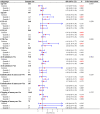Association between serum calcium level and the risk of acute kidney injury in ICU patients with subarachnoid hemorrhage: a retrospective cohort study
- PMID: 39726758
- PMCID: PMC11670206
- DOI: 10.3389/fneur.2024.1433653
Association between serum calcium level and the risk of acute kidney injury in ICU patients with subarachnoid hemorrhage: a retrospective cohort study
Abstract
Aim: This study aimed to evaluate the association between serum calcium level and the risk of acute kidney injury (AKI) in patients with subarachnoid hemorrhage (SAH).
Methods: In this retrospective cohort study, data on adults from the Medical Information Mart for Intensive Care (MIMIC-III and MIMIC-IV) databases, spanning from 2008 to 2019, were extracted. In the logistic regression models, confounding variables, including age, white blood cell (WBC), systolic blood pressure (SBP), heart rate, blood urea nitrogen (BUN), glucose, international normalized ratio (INR), and the Charlson Comorbidity Index (CCI), were finally adjusted by stepwise regression. The outcome event was the occurrence of AKI after intensive care unit (ICU) admission. The univariate and multivariate logistic regression models were utilized to assess the association between serum calcium level and the risk of AKI in SAH patients, with odds ratios (ORs) and 95% confidence intervals (CIs). To further explore the association, subgroup analyses were performed, stratified by age, Glasgow Coma Scale (GCS) scores, drugs, and surgical methods.
Results: A total of 1,128 patients with SAH were included in the study, of which 457 patients developed AKI. Low levels of serum calcium were significantly associated with a high risk of AKI in patients with SAH, with an OR (95%CI) of 1.38 (1.01-1.89). Further subgroup analyses showed that low levels of calcium were significantly associated with a high risk of AKI in SAH patients aged ≥60 years (OR = 0.27, 95%CI: 0.09-0.83), who had GCS score ≥13 (OR = 1.57, 95%CI: 1.08-2.30), who did not use calcium channel blockers (CCB) (OR = 2.22, 95%CI: 1.16-4.25) and angiotensin-converting enzyme (ACE) inhibitors (OR = 1.51, 95%CI: 1.06-2.14), and who did not undergo aneurysm embolization (OR = 1.48, 95%CI: 1.01-2.17) and aneurysm clipping (OR = 1.45, 95%CI: 1.04-2.01).
Conclusion: The results of our study indicated that low levels of serum calcium were significantly associated with the risk of AKI in patients with SAH.
Keywords: AKI; ICU; MIMIC database; SAH; serum calcium.
Copyright © 2024 Zhao, Xiao, Zhao, Liu, Huang and Xiao.
Conflict of interest statement
The authors declare that the research was conducted in the absence of any commercial or financial relationships that could be construed as a potential conflict of interest.
Figures
References
LinkOut - more resources
Full Text Sources
Miscellaneous




